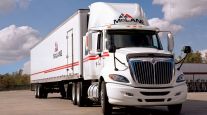Unveiling a Fuel-Efficiency Rule
After months of anticipation and concern, the trucking industry finally got a look last week at the federal government’s first proposal to regulate the fuel-efficiency and carbon-dioxide output of commercial trucks.
The initial reactions from most corners of the freight industry were quite positive.
The proposal — from the Environmental Protection Agency and the National Highway Traffic Safety Administration — breaks the freight industry into nine major truck categories and sets standards based on carbon emissions per ton-mile and gallons of fuel per ton-mile. (Click here for p. 1 story, this week’s issue.)
The trucking industry had been concerned that the federal agencies might try to impose a simple miles-per-gallon standard similar to those for cars.
Instead, the agencies acknowledged that trucks performing different tasks needed to be measured differently, much to the trucking industry’s relief.
And, according to initial reports from truck and engine makers, the proposed standards — which would be introduced in two phases, in 2014 and 2017 — probably can be reached without major truck price increases.
Assuming there are no surprises, said one official at Volvo Powertrain, “my sense is that we will accelerate some of the fuel-efficiency improvements that we have already planned, but there won’t be dramatic changes” in vehicles.
Even better for trucking, there’s actually some good news, and not just an absence of bad news, in this proposal.
“This is probably the only regulation, at least from EPA, that I’ve seen in doing this line of work over the last 20 years that is actually going to be getting us something back in return,” said Glen Kedzie, the environmental counsel at American Trucking Associations.
What Kedzie was referring to is that this rule on fuel efficiency and carbon emissions actually will cut fuel costs for fleets.
In the past, most new regulations from these agencies — including the mandated modifications in heavy-duty engines to cut pollution-causing emissions, which sharply degraded fuel efficiency for several years — have led to costly changes for trucking.
It’s heartening to see that the government regulators not only consulted industry experts that make trucks and that operate them but also actually listened to them.
While the new rule undoubtedly will complicate some aspects of moving the nation’s freight, it’s good to see that the initial proposal appears to be something that the government and the industry can live with, and one that actually might help trucking improve its operations.


